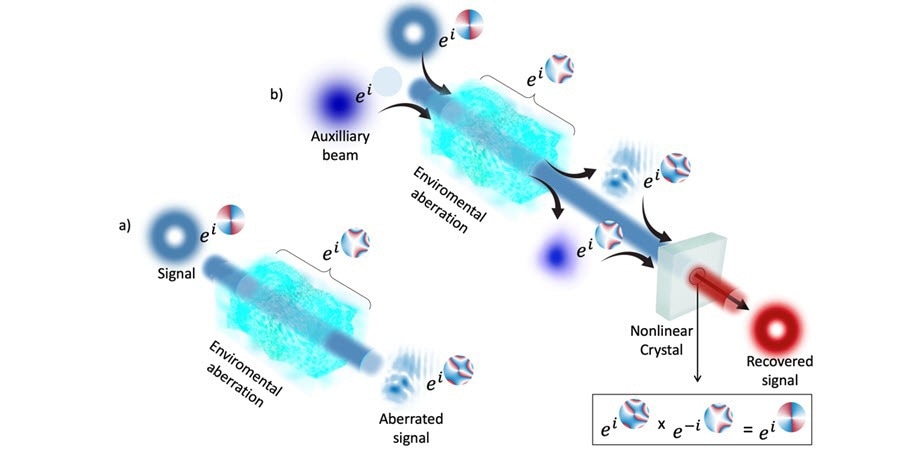A method for manipulating structured light without distorting it has been discovered by researchers; this is significant for applications in industries like imaging and sensing, where accurate light management is essential, and it also opens up new avenues for structured light systems error correction.
 Structured light passing through a noisy environment gets distorted (a), but if another unstructured beam also gains the same distortion, the effect can be undone by mixing them in a nonlinear crystal (b). Using difference frequency generation, the structured beam is automatically restored without the need for any knowledge of the aberration, for a nonlinear form of adaptive optics that works at the speed of light. Image Credit: B. Sephton (Università degli studi di Napoli “Federico II”)
Structured light passing through a noisy environment gets distorted (a), but if another unstructured beam also gains the same distortion, the effect can be undone by mixing them in a nonlinear crystal (b). Using difference frequency generation, the structured beam is automatically restored without the need for any knowledge of the aberration, for a nonlinear form of adaptive optics that works at the speed of light. Image Credit: B. Sephton (Università degli studi di Napoli “Federico II”)
Light’s numerous qualities enable it to be controlled and exploited for a wide range of applications, including highly sensitive measurements, communications, and intelligent object interrogation. The spatial pattern known as structured light, which can resemble objects such as donuts and flower petals, provides an appealing level of flexibility. For example, designs with varying numbers of petals can represent letters of the alphabet and, when examined from the opposite side, convey a message.
Unfortunately, the same characteristics that make these patterns sensitive to measurements also leave them vulnerable to undesired external influences, such as air turbulence, aberrated optics, strained fibers, or biological tissues that alter the structure through their own “patterning.” In this case, the distorted pattern could worsen to the point where the output pattern diverges greatly from the input, making it useless.
Traditionally, the solution has been to apply the same distortion again. This can be done by measuring the distortion, applying the reverse, or reversing the distortion in the beam and sending it back into the aberration, allowing it to “undo” itself.
Researchers from Italy and South Africa have recently demonstrated that, by matching an aberrated light beam that comes from a noisy environment with another unstructured beam that also underwent the same aberration, the aberrated light can be corrected back to its original state. They demonstrated, using a variety of optical distortions, that light-correcting light is naturally produced by passing them all into a nonlinear crystal, even for extremely complicated forms of the aberrations that made the original structure unrecognizable.
They accomplished this, as described in Advanced Photonics, by taking advantage of a phenomenon known as difference frequency generation, in which two light beams passed through a particular kind of material called a nonlinear crystal produce a third beam that possesses the characteristics of the two input beams.
The most important thing to remember is that the output aberration is the difference between the two input aberrations; if they are the same, light can correct light and produce an aberration-free after-crystal output.
One fascinating feature of this study is that the correction is automatic and follows the signal, allowing for real-time rectification of patterned light without requiring knowledge of the disturbance or reapplying the same aberration using additional, more involved stages. This results in a ready-made, small solution that can be easily incorporated into systems that use these structures for a variety of purposes, such as optical trapping, imaging, and communications.
A by-product of this process is the added benefit of communication and sensing using different wavelengths. For example, conveying information using eye-safe wavelengths, probing biological samples at penetrating wavelengths while detecting at wavelengths where observation technology is well established.
Journal Reference:
Sigh, S., et al., (2024) Light correcting light with nonlinear optics. Advanced Photonics. doi:10.1117/1.AP.6.2.026003